6 Sales Collateral Examples: Tips, Tricks, and More
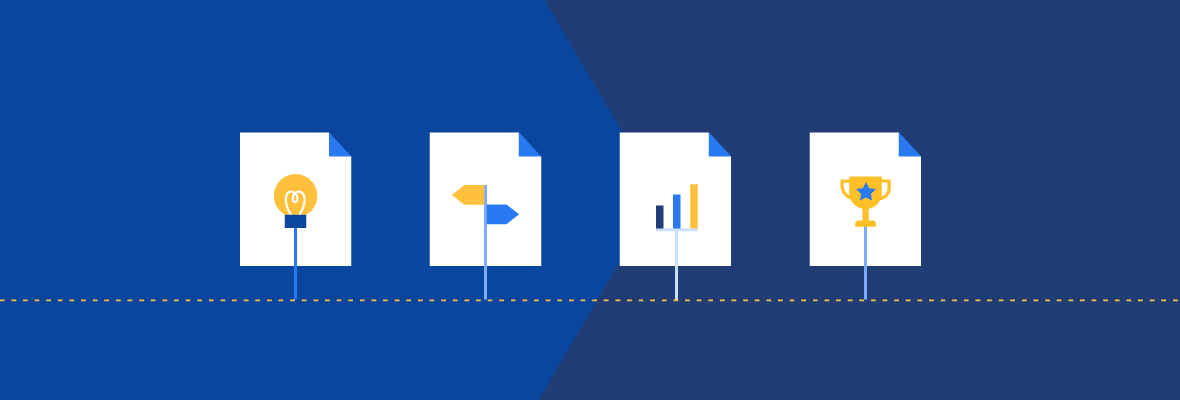

Tim Edwards
This post was originally published in June 2019 and has been updated for accuracy and comprehensiveness.
Before we dive into how and when you should be making the most of specific forms of sales collateral at specific points in the sales funnel, let’s make sure we have a well-defined understanding of what sales collateral is and the potential value it can provide when introduced to prospects at the right time in the right way. In this post, we’ll dive into six sales collateral examples and explore why they are highly effective.
Sales collateral is a collection of informative, persuasive documents used to give prospects a better understanding of a company and the products or services they’re looking to provide. These documents are critical assets for sales teams looking to inform prospects and customers about their company, its offerings, and its proven success. When presented at the right time in the right way, they have a direct influence on your prospects making a purchase.
Before you get there, you need to determine whether you’re getting the most possible value out of your current sales collateral. To make this happen, you need to ensure that both the content of your collateral and how your sales teams make use of it actually align with where each individual buyer currently finds themselves in the buyer’s journey – the collective series of steps customers go through during the buying process.

Download the Ultimate Guide to the B2B Buyer’s Journey
Learn how to create a seamless buyer journey — from discovery at a trade show event to creating loyal brand advocates.
At EBQ, we divide the buyer’s journey into five specific stages:
- Awareness: The buyer starts their journey once they become aware of a problem in need of a solution.
- Consideration: The buyer assesses and compares the benefits and drawbacks of your solution with alternative options.
- Decision: The buyer decides whether or not to make a purchase after doing additional research and your sales teams conduct additional nurturing efforts.
- Growth: If you’ve done everything right, the education and guidance you provide this new customer during onboarding will help them grow.
- Delight: Buyers experience delight once they feel adequately supported by your company and begin promoting it to others.
Sales collateral is a compelling tool that can and should be used to convince your prospects to move further down the sales funnel. Collateral is especially useful if you’re a B2B startup company like ours that regularly experiences longer sales cycles, larger deal sizes, and the expectation of winning over the full buying committee before a deal can be closed.
In this post, we’ll go over the essential types of sales collateral you absolutely need in your repertoire. We’ll also share some of our most effective examples and our own best practices for designing and using sales collateral effectively.
Awareness: The prospect becomes aware of a problem
Company Overview
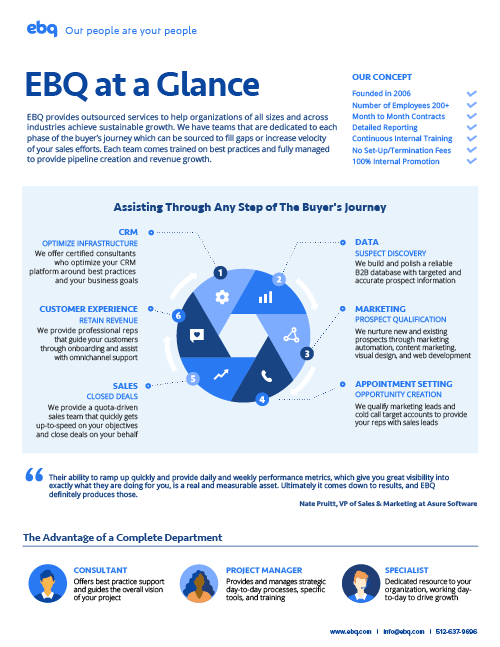
Since this is the very first stage of the buyer’s journey, your prospects are likely only just discovering that they have a problem that needs solving. In many cases, they may have recognized the need for a solution like yours, but just haven’t gotten acquainted with your offering.
So, get acquainted. Take advantage of the opportunity by introducing your business with a company overview that positions your products or services as the best possible solution to the pains they’re currently experiencing.
Here’s a scenario: Buyers at a trade show are considering new vendors to partner with, but clearly aren’t sure where to start. This is a perfect opportunity to put awareness state-level sales collateral – like your company overview – right in their hand.
In our company overview, we include our mission statement, a summary of our 6 core services, a client testimonial, and some brief operational details about our organization and offerings. Think of it as putting our homepage on a piece of paper.
While in the awareness stage of the buyer’s journey, your teams should be using sales collateral to capture the attention of top-of-funnel prospects and drive them to want to learn more about your solution.
While buyers in the awareness stage may not be considering purchasing a solution just yet, using this type of sales collateral serves as a means to plant the idea in their heads that an offering like yours may be the perfect remedy to their recently identified problem.
Company Overview Use Case: In addition to the trade show scenario, your sales development rep (SDR) might also use an awareness stage sales collateral piece like the company overview in a follow up email to leads who have yet to accept a sales meeting. By giving them a broader overview of what your company provides, the SDR can spark their curiosity and encourage the prospect to schedule a sales meeting or demo for a more comprehensive rundown.
Consideration: The prospect considers your offering along with others
Product one-pagers
In the consideration stage, prospects aren’t just assessing the pros and cons of your offering, they’re exploring all of their options to find the right one to solve their problem. When competition is fierce, your sales collateral needs to be especially compelling.
One type of sales collateral that fits the bill in this stage is a product (or service) one-pager, which provides an overview of relevant value propositions for your offering and how those value props can be seen as a solution to the prospect’s pain points.
The service overview pictured here is for our outsourced marketing service and gives a rundown of the different areas of support our service provides. It addresses and counters the specific pain points our prospects typically experience, such as the high costs of developing an internal marketing team vs. our outsourced solution.

Product One-pagers Use Case: Your salespeople can use these two types of sales collateral while nurturing qualified prospects to show those buyers exactly how your solution will address and resolve every one of their pain points that were identified before the prospect entered the consideration stage.
Decision: The prospect finally decides whether to purchase your solution or not
Case studies

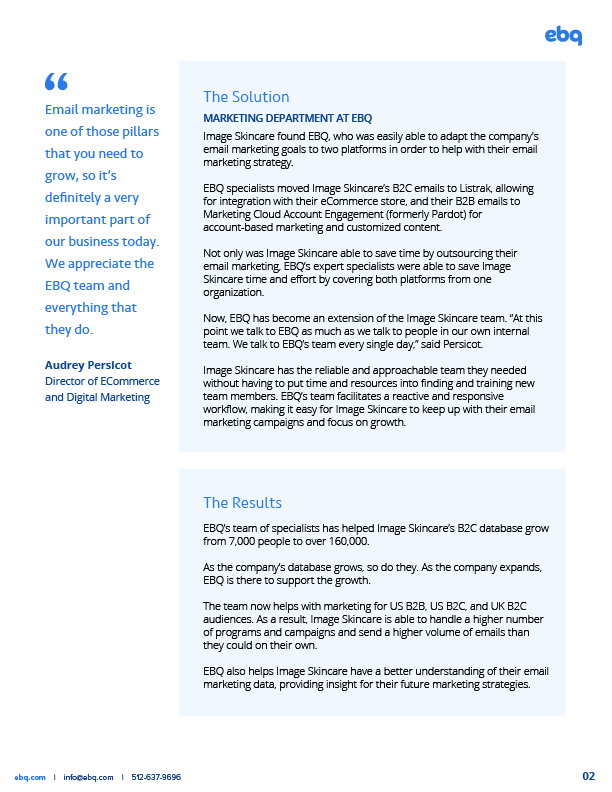
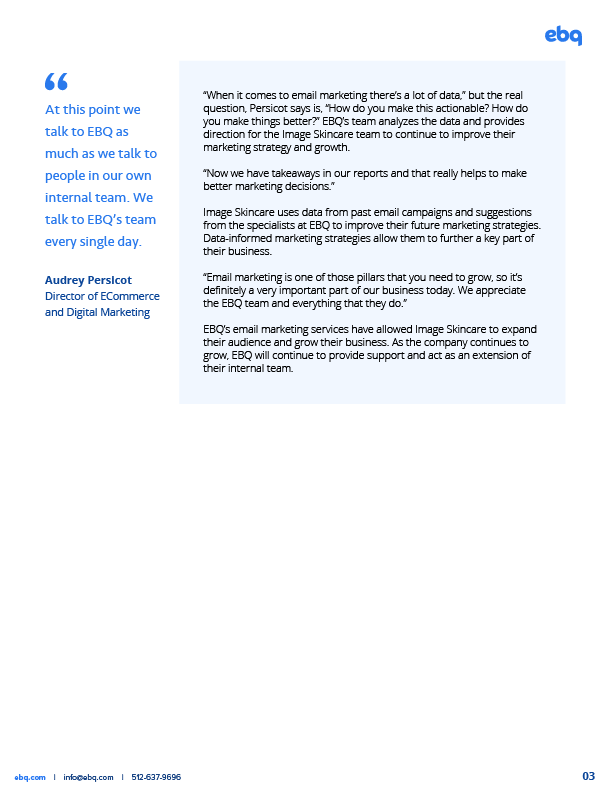
The decision stage is the make-or-break stage. It’s the part of the buyer’s journey where your prospect makes their final, definitive choice as to whether they will purchase your solution or go with another. In this stage, your goal is obvious – encourage your prospect to buy and help them navigate the buying process. With B2B startups, this phase typically also comes with the caveat that you need to win over the prospect’s full buying committee before a deal can be struck.
As such, case studies are the perfect piece of sales collateral to use in the decision stage. By providing the prospect with success stories from past customers – especially customers similar to the prospect’s company or industry – case studies help to create a better visualization of exactly how your product or service will help your prospect.
In our Image Skincare case study pictured above, we provide a detailed description of how our service was implemented into the client’s existing processes as well as the measurable outcomes that came as a result of our involvement. On that note, be sure that your case studies document a variety of wins – both operational and financial. This will give prospective buyers a better idea of how your solution can help with both.
Case Studies Use Case: When and if it’s possible, salespeople should always attempt to send prospects case studies that provide an example from within the prospect’s own industry. The more tailored your case study is to the buyer, the easier it is to illustrate what a successful use of your product or service looks like.
Client presentations
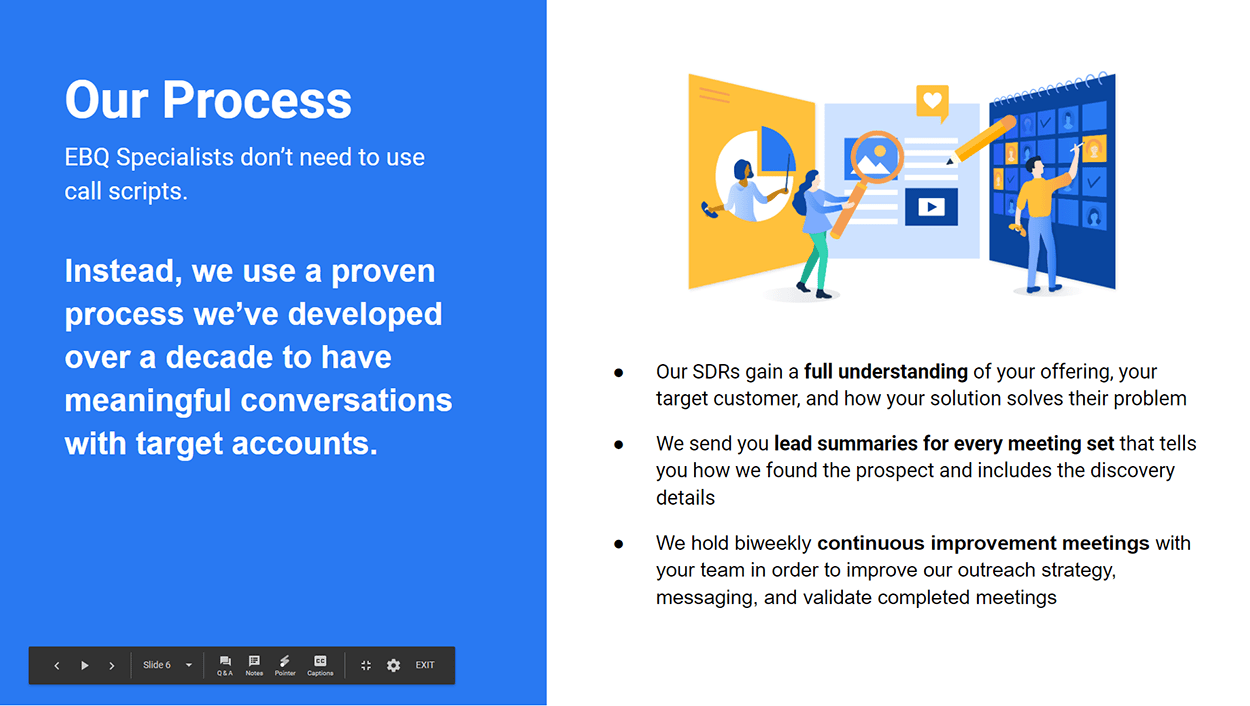
As prospects edge closer to making their final purchasing decision, those who adopt a more personalized approach to selling are the ones more likely to turn that prospect into a customer. At this stage, a client presentation is the perfect piece of sales collateral to call on since it outlines potential benefits and expectations, specific to the buyer it’s presented to.
In the client presentation slideshow we’ve provided, we go into detail on the expectations we set for our day-to-day processes, our recommendations for that specific client, and an outline of exact costs and potential ROI.
Client Presentation Use Case: Client presentations are typically used by salespeople as they attempt to get the prospect to finalize their decision and work to close a new deal. Presenting this information to every person who gets a say in the purchase decision can be an effective way to get the buying committee to come to a consensus and address any potential last-minute concerns that crop up.
Growth: The customer grows through your education and guidance
Onboarding documents
So, you successfully made the sale. From here, there’s no further need for sales collateral, right? Wrong. It may come as a surprise, but not only is sales collateral still valuable in the growth stage, it’s also beneficial in every stage after a deal has been closed.
In the growth stage, buyers work through onboarding and implementing your solution into their existing processes. Here, it should be your goal to ensure the customer gets every last drop of value out of your solution and to anticipate where further value could be added.
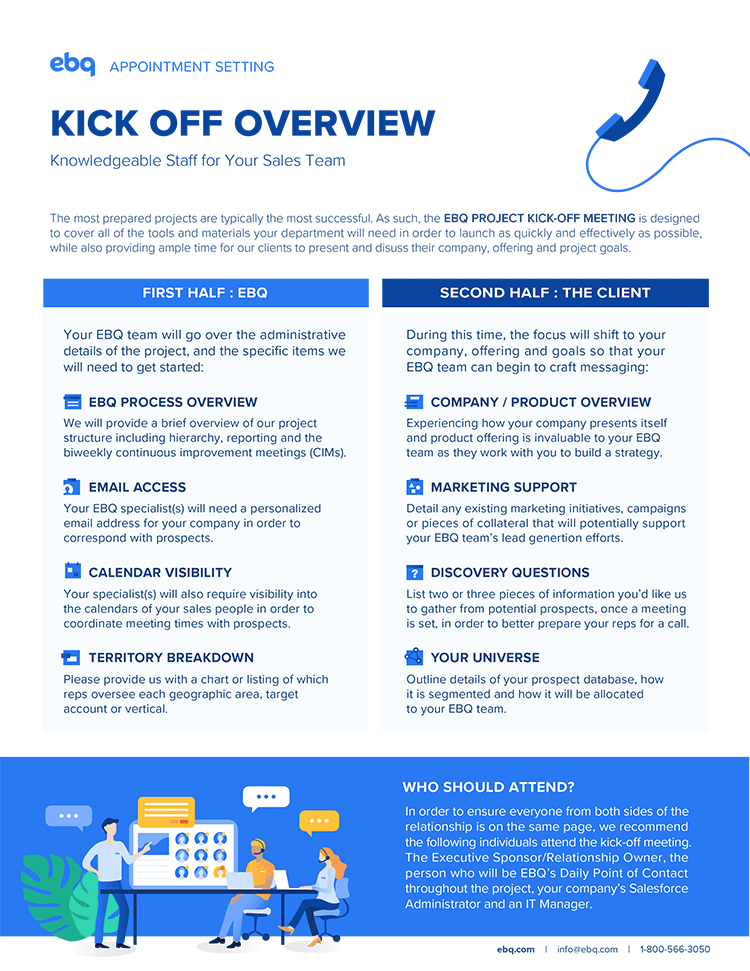
Sales collateral like your onboarding documents (which can also be useful when setting expectations in the decision stage) can be used to guide buyers through the implementation process and ensure a seamless, successful adoption of your solution.
In the kick-off overview for our appointment-setting service, we outline all of the administrative and operational components that are needed for effective implementation and a strong partnership with the client.
As you and your customers work through the growth stage, it’s important to ensure that the latter are set up for success right from the start. In this stage, it’s important that customers are set up for success from the start, so your organization can get to work on increasing renewals and avoiding cancellations from those who never properly implemented your solution.
Also, consider opportunities for an increased deal size that can arise in this stage when you present further options to customize or supplement the product or service they’ve purchased.
Onboarding Documents Use Case: This kind of sales collateral should be used by your customer success managers to foster customer satisfaction with the intention of improving renewal rates. As your SMs address each phase of implementation, they can use collateral like this to cross-sell or upsell new customers on additional products or related services that would add more functionality to the solution.
In the case of our appointment-setting example, our collateral for this stage might highlight how adding another SDR could bring in more qualified appointments or how utilizing our marketing services can provide more warm inbound leads for the SDR team to call on.
Delight: The customer is so delighted by your support that they promote your services to others
Once a customer enters the delight stage, your relationship with them will begin to ramp up as they continue to use your product or service and depend on you for support. Your goals in this stage should be to increase sales through customer satisfaction, increase customer retention, and build brand advocacy.
Some of the best types of sales collateral that we suggest using in this stage include:
- Customer appreciation flyers that prompt your customers to provide feedback about their experience and invite them to leave a review about your product or service
- Informative brochures that teach customers how to increase the utility of their purchase, especially through the use of your additional offerings
- Exclusive coupon offers that give your customers the incentive to refer you to other companies and become advocates for your brand
Delight Stage Sales Collateral Use Case: When your newly-delighted customers come to you for guidance, these are the types of late-stage sales collateral pieces your success managers or customer service reps should be sending them. As the customer’s key point of contact in your company, these reps should make sure customers are getting all of the guidance and support they need to succeed with your product or service and are informed about all that you have to offer.

Subscribe to EBQ's Bimonthly Newsletter

Subscribe to EBQ's Bimonthly Newsletter
Best practices for creating sales collateral
- Stay on brand: If you want to create a strong connection between your company and the value your solution provides, it’s essential that you maintain a cohesive brand identity across all sales collateral. This is where your marketing team gets involved, creating each piece of sales collateral so that all logos, fonts, colors, etc. are consistently applied across all assets.
- Practical formatting: Sales collateral should be formatted with the buyer in mind—easy to follow and designed for readers to scan through quickly. You can do this easily by organizing information into lists or emphasizing main points in different colors to draw attention to the most relevant, important information.
- Include a clear CTA: Each piece of your sales collateral needs a distinct call-to-action or clear suggestion as to what the next step the buyer should take. It could be a hyperlink to learn more about your product or maybe a salesperson’s direct line to discuss finalizing the deal – it all depends on what stage of the sales funnel your prospect is currently in.
Best practices for using sales collateral effectively
- Segment by persona: Start with well-defined buyer personas for your different types of buyers, then segment prospects and customers along dimensions like common pain points and their roles in purchase decisions. Smart segmentation helps when deciding what content will be most persuasive for the individual, like choosing between technical or economic value propositions.
- Map your buyer’s journey: Different buyers take different steps before deciding to invest in a new solution. As such, it’s important that your teams know exactly how to help your customers through each stage of their buyer’s journey. Having a predictive view of a customer’s touchpoints helps your reps know when and how to best provide each piece of sales collateral.
- Team accessibility: Reps should be able to quickly find certain collateral pieces in order to use them at critical points in the sales process. To facilitate this, all sales collateral documents should be stored in a central location that can be easily accessed by the appropriate teams (sales, sales development, customer service, etc.). However, security should also be a concern with regard to how these documents are stored. More personalized collateral may include sensitive customer information which must be adequately protected.

Download the Ultimate Guide to the B2B Buyer’s Journey
Learn how to create a seamless buyer journey — from discovery at a trade show event to creating loyal brand advocates.
Develop sales collateral that proves you understand and can meet your buyer’s needs
With an effective process for designing and distributing your sales collateral in place, you will be more readily able to keep potential buyers informed of your solution (at any point in the buyer’s journey) and help them recognize the value of your product or service.
The biggest thing to take away here is that your sales teams must focus on how to address buyer needs and concerns at every stage of the sales funnel when developing a sales collateral strategy. You won’t get to the decision stage if your efforts fall flat during the consideration stage. You won’t reap the full benefits from your customer relationships if you think sales collateral serves no purpose in the post-sale stages of their journey. Keep these things in mind, and make use of our best practices and proven examples as you develop your own sales collateral strategy.
If you need help creating engaging sales collateral for your teams, feel free to explore EBQ’s marketing services to learn what we can do for you.
